Following Plastic Waste Down Thailand's Chao Phraya River
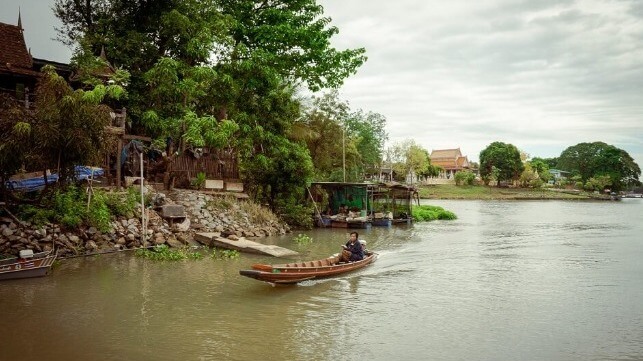
The Chao Phraya starts at the confluence of the Ping and Nan rivers, which meet in Nakhon Sawan province in the heart of Thailand. Although the river’s waters have already traveled half of the country’s length by this point, it is still relatively clean, flanked by villages and farms.
The surrounding land is ideal for growing rice thanks to the river’s annual floods, which come with the monsoon from May to October and provide an ample supply of water and nutrients. In 2012, around 45 percent of land in the Chao Phraya river basin was used for rice farming. Fruit orchards are also common.
But plastics already make an appearance up here. The farms themselves are one indirect source – the material is used extensively in agriculture across Thailand.
 In a nearby mango orchard, plastic bags are tied around the fruit to protect them from pests. Once the fruit is harvested, the bags are usually thrown away. (Image: Mailee Osten-Tan / The Third Pole)
In a nearby mango orchard, plastic bags are tied around the fruit to protect them from pests. Once the fruit is harvested, the bags are usually thrown away. (Image: Mailee Osten-Tan / The Third Pole)
Floods bring plastic to ancient capital
The floods that bring water and nutrients to crops along the Chao Phraya also draw plastic into the river.
South of Nakhon Sawan, the Chao Phraya flows through the ancient city of Ayutthaya, which was the capital of Thailand until 1767. Built at the point where two other rivers join the Chao Phraya, the city is crisscrossed with canals, and traditional ways of life here are closely connected to the water. Seasonal flooding is expected, with homes along the waterways built on stilts to accommodate the higher water levels. But climate change and a range of other factors is intensifying rainfall, and severe flooding is a growing problem in the city.
Ratimaporn Pakorn is a 23-year-old boat driver in Ayutthaya. Her home was flooded in 2021 after unusually heavy rainfall. “The area floods nearly every year, but the extent of it varies. Last year, the water came all the way up to my calves,” she recalls.
Ratimaporn Pakorn drives her family’s boat on the Chao Phraya at Ayutthaya. Behind her a tug pulls a barge loaded with sand. Sand is extracted at numerous points along the river, which could be reducing the watershed’s capacity to absorb floodwaters. (Image: Mailee Osten-Tan / The Third Pole)
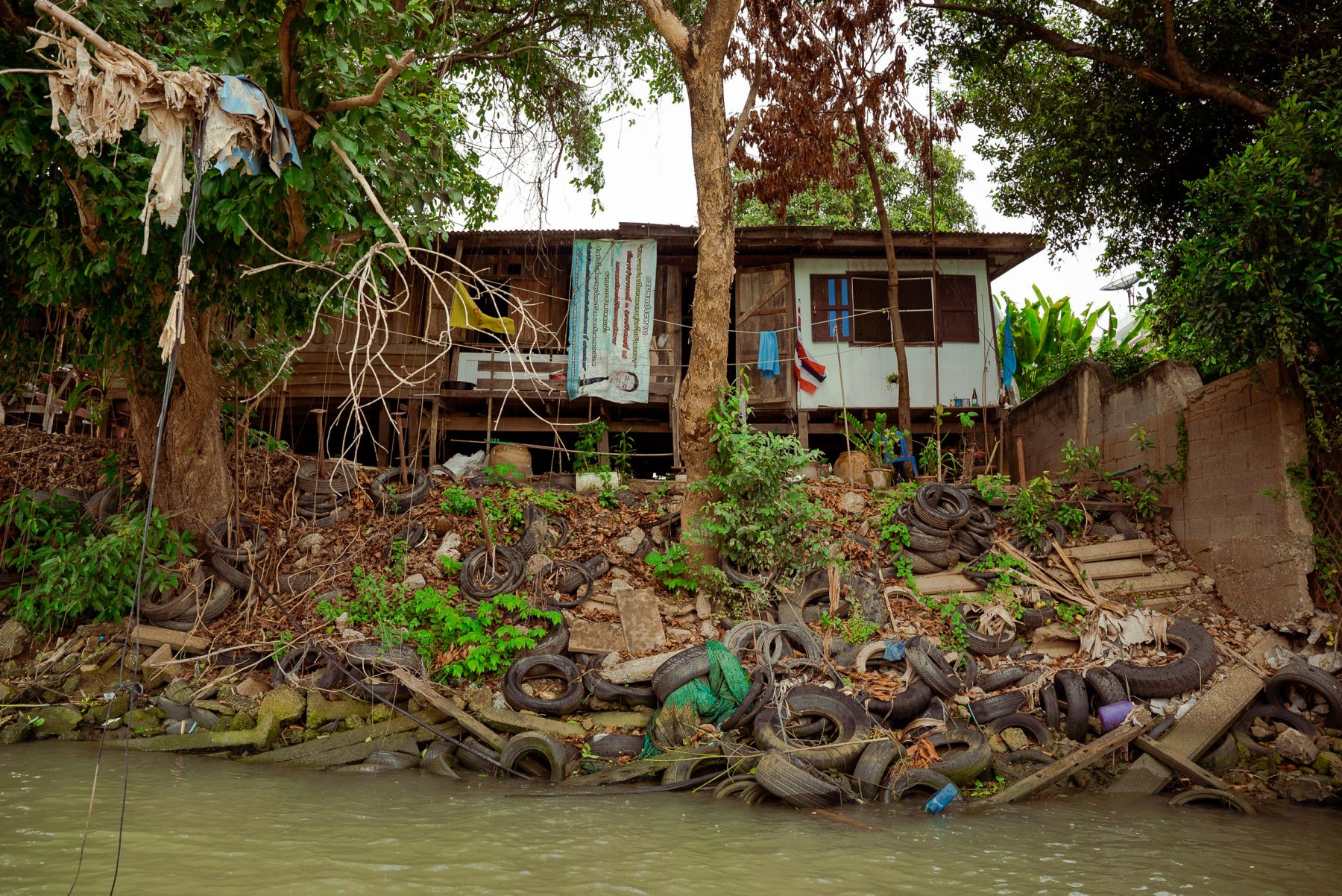 Many of the houses that line Ayutthaya’s waterways are built on stilts to accommodate regular flooding. This household appears to have shored up its defences using old tyres. (Image: Mailee Osten-Tan / The Third Pole)
Many of the houses that line Ayutthaya’s waterways are built on stilts to accommodate regular flooding. This household appears to have shored up its defences using old tyres. (Image: Mailee Osten-Tan / The Third Pole)
As a UNESCO World Heritage Site, the ancient capital attracts tourists from around the globe, many of whom take boat tours to view its famous temples. Ratimaporn relies on these tourists to make a living.
“It’s dirty,” says Ratimaporn, noting that plastic can be seen floating in the river, where it often clogs her propellers. She worries that this will impact tourists’ perceptions of the city.
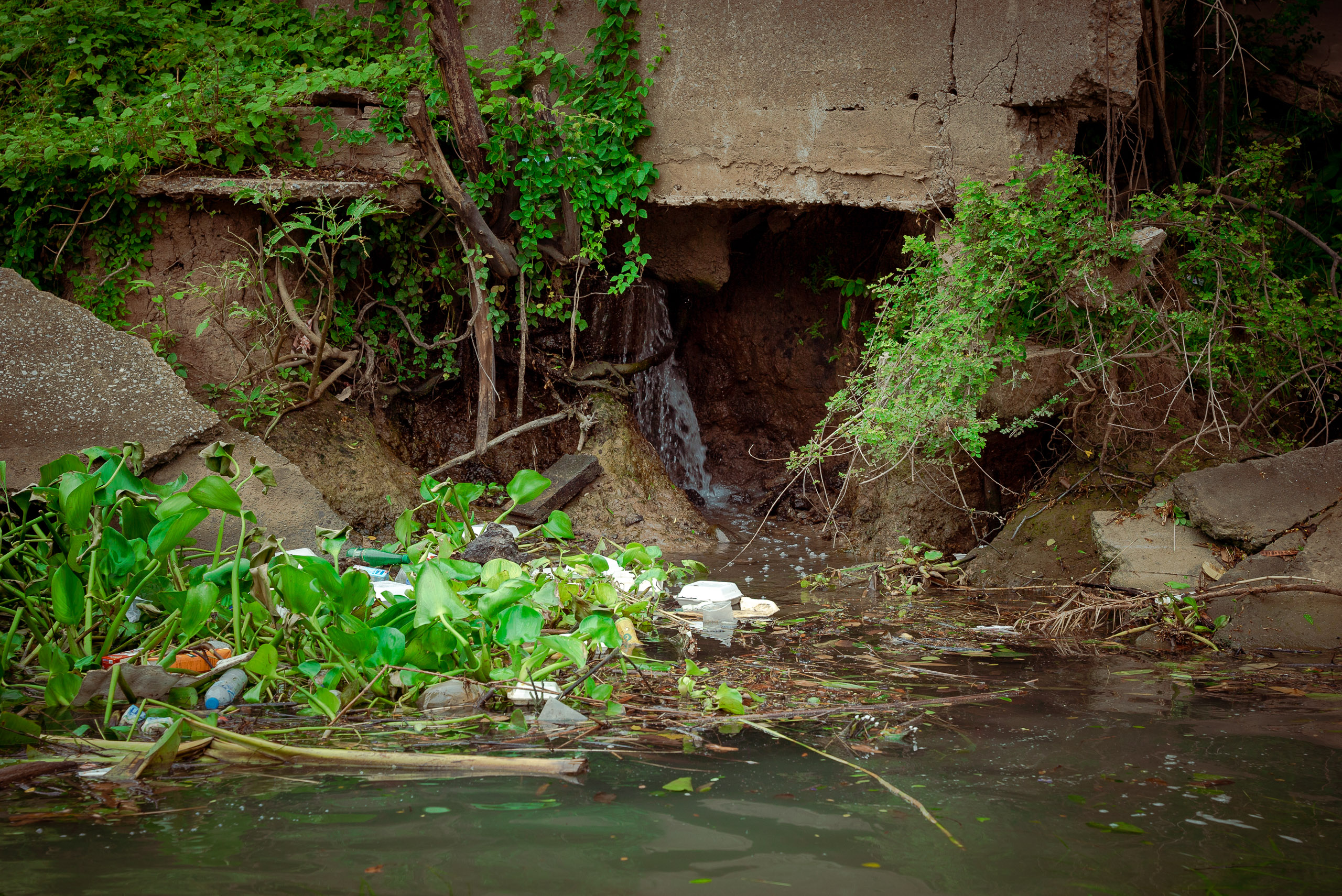 Water hyacinth is an invasive species on the Chao Phraya and can cause problems, blocking routes and reducing oxygen in the water. It also traps plastic waste, causing unsightly garbage floats. (Image: Mailee Osten-Tan / The Third Pole)
Water hyacinth is an invasive species on the Chao Phraya and can cause problems, blocking routes and reducing oxygen in the water. It also traps plastic waste, causing unsightly garbage floats. (Image: Mailee Osten-Tan / The Third Pole)
Plastic-clogged canals
As the Chao Phraya snakes through densely populated central Thailand and on to the country’s modern-day capital, Bangkok, it’s often treated as a catch-all waste disposal unit.
Much like Ayutthaya, Bangkok grew from a settlement built on canals that borrowed the waters of the Chao Phraya to form convenient transport routes. These canals, known as khlongs in Thai, remain a significant feature in today’s megacity, which has over a thousand, lined with settlements and home to over 23,500 mainly low-income households. Many are choked with plastic.
Sira Leepipattanawit is a community leader who grew up on the Bangkok Yai canal. Many of the communities along Bangkok’s canals are hard to reach by road, making it difficult to access municipal services. Throwing waste directly into the water is an old habit. Although this is now officially illegal, and people could be fined, Sira explains that it’s almost impossible to identify the culprits. Houses are often situated directly above the water, and residents “can easily open their window and plop their trash bag into the water when no one’s looking – at night, for example”, he says.
This used to just be an easy way to deal with household waste. But in the old days, this waste was organic. Today, everyday items come wrapped in plastic – not just in Bangkok, but all over Thailand.
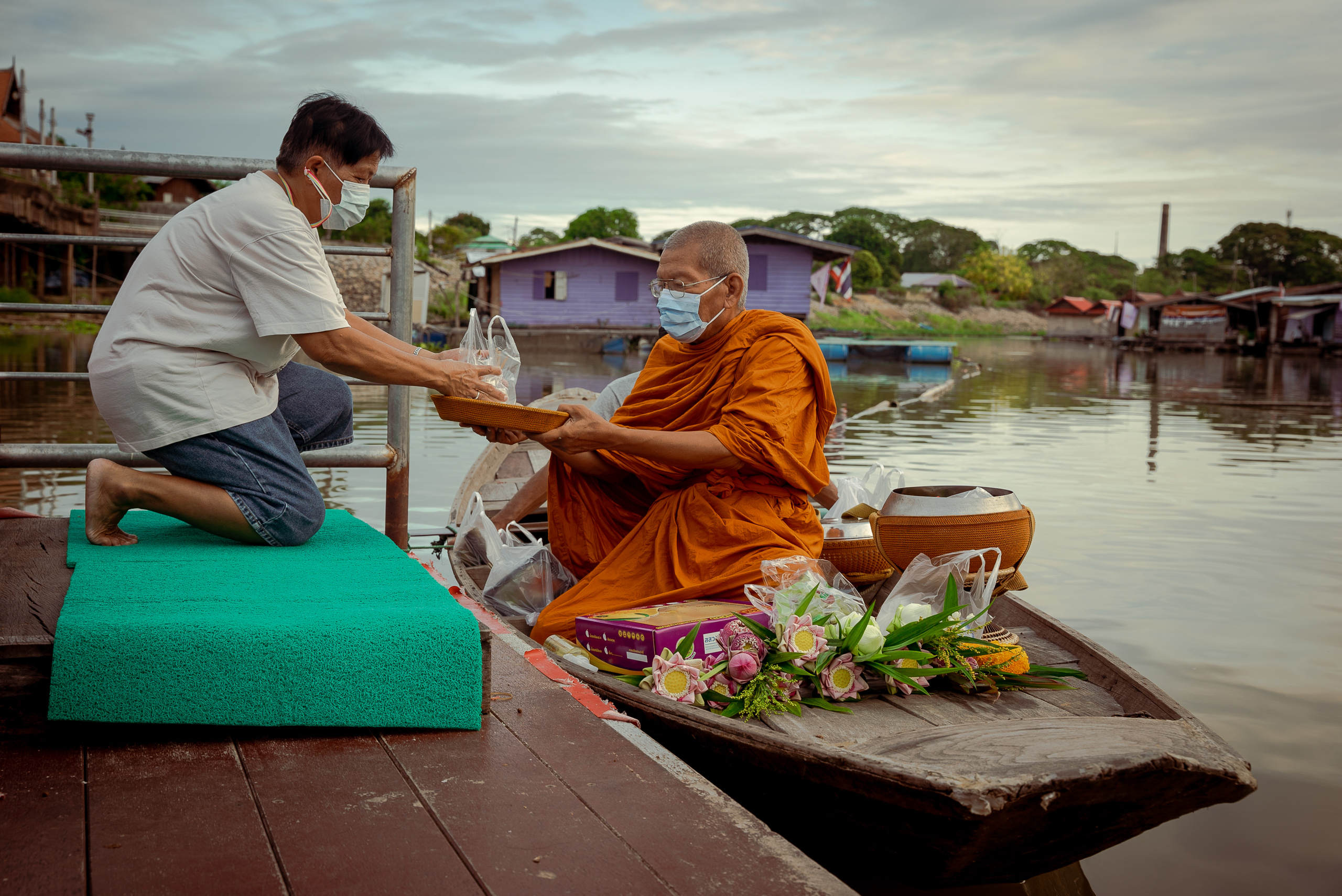 Nearby, a riverside resident offers alms to a monk. Even this traditional practice now comes with single-use plastic bags. (Image: Mailee Osten-Tan / The Third Pole)
Nearby, a riverside resident offers alms to a monk. Even this traditional practice now comes with single-use plastic bags. (Image: Mailee Osten-Tan / The Third Pole)
 Takeaway street food, which many Thais eat daily, is now nearly always served in plastic (Image: Mailee Osten-Tan / The Third Pole)
Takeaway street food, which many Thais eat daily, is now nearly always served in plastic (Image: Mailee Osten-Tan / The Third Pole)
On a Monday afternoon on the Bangkok Yai canal, tourists cruise around on long-tail boats while children swim among old flip-flops and polystyrene fragments. Still, the water here is at least relatively clean. On the other side of the city, at the Lat Phrao canal, the scene is different. The water has a tar-like consistency and a putrid stench envelops the whole area.
“It’s from the wastewater and all the junk,” explains Samnieng Bonlu, a 66-year-old resident who has lived on the Lat Phrao for most of his life. Notoriously polluted, the canal was built to help drain rainwater away from the city into the Chao Phraya. Over its 31-kilometer length, the canal is home to over 7,000 low-income households.
Samnieng recalls that the area used to be mainly paddy fields, but as the urban population sprawled, it turned into a popular area for rural migrants to gain a foothold in Bangkok.
“I’ve seen a change in the way of life, with more housing along the river as people move in, and with people using more plastic,” says Samnieng.
Samnieng now works with the TerraCycle Global Foundation, a project of the recycling company TerraCycle that aims to capture plastic waste along rivers and canals before it flows into the ocean. The foundation’s Lat Phrao clean-up project started in July 2020.

In 2020, TerraCycle installed two metal cages on the Lat Phrao canal to catch waste before it reaches the Chao Phraya. Once caught, it’s easier for the team to manually scoop the waste from the water. (Image: Mailee Osten-Tan / The Third Pole)
Mangroves and marine life
Mangroves grow along the last stretch of the Chao Phraya, perfectly adapted to the brackish water where the river meets the sea. At the mouth of the Chao Phraya, the muddy mangrove forests of Samut Prakan province are covered in plastic, a testament to how much waste the river is carrying.
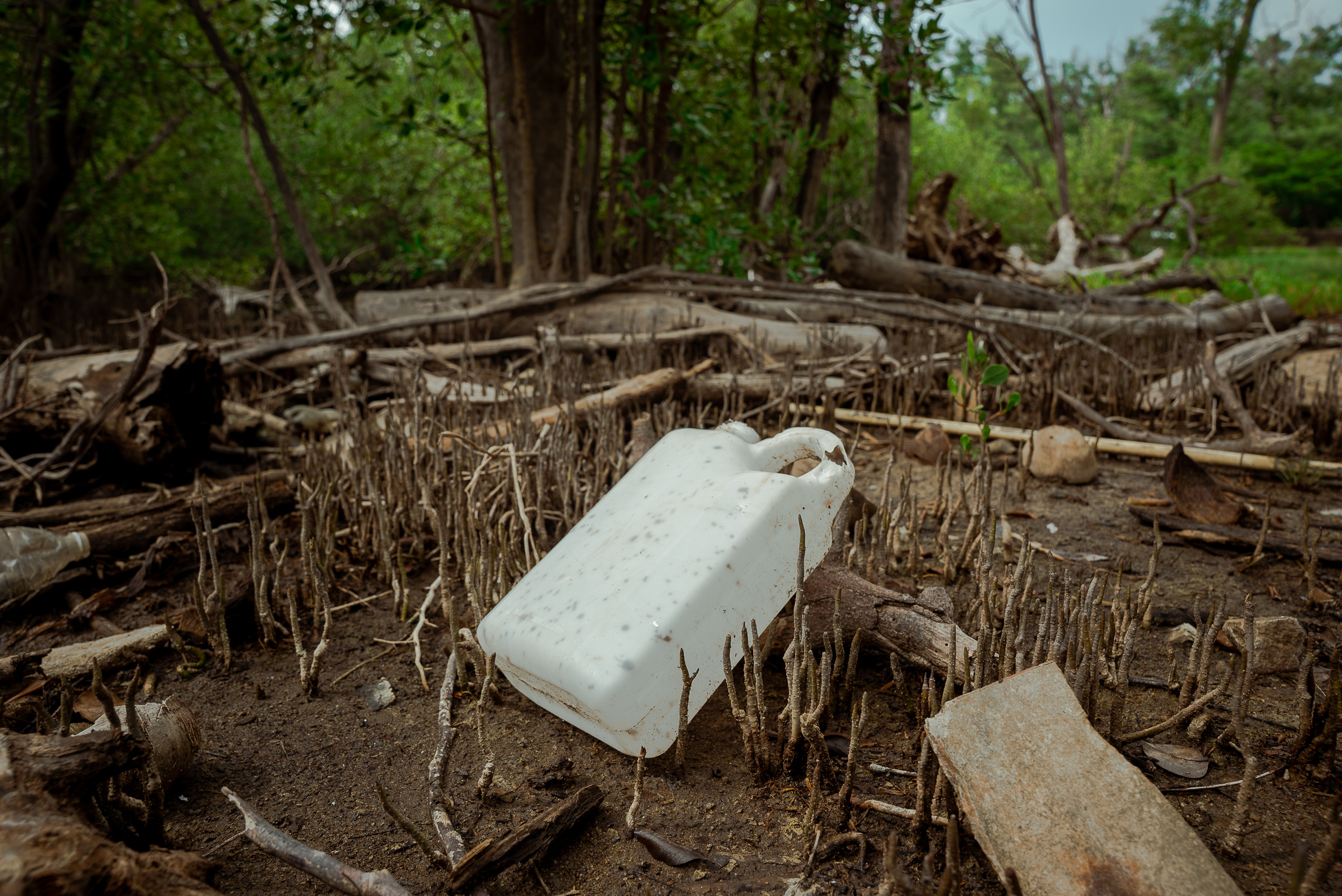
The tangled roots and mud of the mangrove forests in Samut Prakan trap large amounts of plastic waste carried by the river. By this stage, a lot of the waste has already been broken down into microplastics. (Image: Mailee Osten-Tan / The Third Pole)
What waste does not get caught by the twisted roots of the mangroves is funneled out into the Gulf of Thailand.
Rivers are an important contributor to plastic waste in the world’s oceans, says Suchana Chavanich, a professor with the Department of Marine Science at Chulalongkorn University in Bangkok. “We estimate about one to two million tonnes of the plastic waste ending up in the ocean is from rivers,” she says. The situation is particularly bad in Asia, which is home to the world’s “top 20 polluting rivers”.
This is having a major impact on marine life, with animals not only becoming entangled in debris, but also mistaking items like plastic bags for food.
In 2018, a pilot whale was found dead in southern Thailand after it swallowed 80 plastic bags, leaving it unable to eat.
Suchana explains that animals like sharks and sea turtles are “top predators that control the marine ecosystem. If their population declines, and they die because of plastic waste consumption, it impacts the health of the ecosystem.”
The big problem with microplastics
By the time the Chao Phraya reaches the sea, a lot of the plastic waste it’s carrying is too small to see, having been broken down into microplastics (defined as pieces smaller than five millimeters).
Research has found that microplastics harm the health of mangrove ecosystems by hindering gas exchange and releasing harmful chemicals. They are also entering aquatic food chains, not to mention our own bodies. “Scientists have found that we can [consume] microplastics through the food that we eat, the water that we drink, and the air that we breathe,” says Suchana.

This fish farm in Ang Thong province, opposite Thailand’s only viscose factory, raises red tilapia. Aquaculture is common on the Chao Phraya, and another source of plastic pollution both big and small. Exposed to the elements, the plastic nets and floats used on the farms slowly disintegrate, releasing microplastics into the water. (Image: Mailee Osten-Tan / The Third Pole)
Microplastics have even been found in human blood. The impact on humans is still a relatively new area of research that requires time to establish causal links. But already, studies are showing that the consumption of seafood that contains microplastics can have implications for our health.
Roadmaps to preventing plastic pollution?
In 2019, the Thai Ministry of Natural Resources and Environment released the Roadmap on Plastic Waste Management (2018-2030). The plan outlines targets for various agencies to reduce plastic waste, including a proposed ban on four types of single-use plastic by 2022: lightweight plastic bags, polystyrene food containers, plastic cups and plastic straws. However, the Covid-19 pandemic interfered with the achievement of these targets and reportedly triggered a rise in plastic use.
A staff member at TerraCycle’s base in Bangkok sorts through waste collected from the Lat Phrao canal to pick out recyclable plastics. Removing waste before it reaches the sea can reduce some of the Chao Phraya’s impact on marine plastic pollution. (Image: Mailee Osten-Tan / The Third Pole)
 Once sorted, the recyclable waste is press packed and sent to a recycling facility where it is turned into plastic pellets that can be used to make items such as chairs and bottles. Recycling plastic reduces its quality, and so can only be repeated a few times without adding virgin plastic. (Image: Mailee Osten-Tan / The Third Pole)
Once sorted, the recyclable waste is press packed and sent to a recycling facility where it is turned into plastic pellets that can be used to make items such as chairs and bottles. Recycling plastic reduces its quality, and so can only be repeated a few times without adding virgin plastic. (Image: Mailee Osten-Tan / The Third Pole)
In 2021, the Department of Marine and Coastal Resources announced a collaboration with non-profit The Ocean Cleanup to tackle riverine plastic pollution in the Chao Phraya. The project includes deploying a vessel known as the Interceptor to collect plastic debris, as well as monitoring the flow of plastic waste through bottle-tagging and placing cameras on bridges along the river.
“[Through this research], we can gain an accurate measure of how much [plastic] waste is passing through the river,” says Suchana. “Hopefully this data will be very useful for further management in this area.”
Though the Thai government and non-government organisations are trying to better manage plastic waste in the rivers and oceans, Suchana stresses that the best solution is to prevent plastic from getting into waterways in the first place.
“When plastic waste goes from the river into the ocean… it takes [up to] 500 to 600 years to decompose. So you can see that once it gets there, it will stay there almost forever,” Suchana says.
For Sira Leepipattanawit from the Bangkok Yai canal, “This is a problem for humanity, not just waterside communities. It is a problem for all lives that starts with us humans.”
This article is a collaboration between The Third Pole and the China Environment Forum’s Turning the Tide on Plastic Waste in Asia initiative. It is also available on the Wilson Center’s New Security Beat blog.
Wanpen Pajai is a journalist based in Bangkok, Thailand. She reports on stories on economic development and the environment in Southeast Asia.
Mailee Osten-Tan is a multimedia journalist in Bangkok, Thailand, whose work often explores social exclusion, gender discrimination, and resilience.
This article appears courtesy of The Third Pole and may be found in its original form here.
The opinions expressed herein are the author's and not necessarily those of The Maritime Executive.
